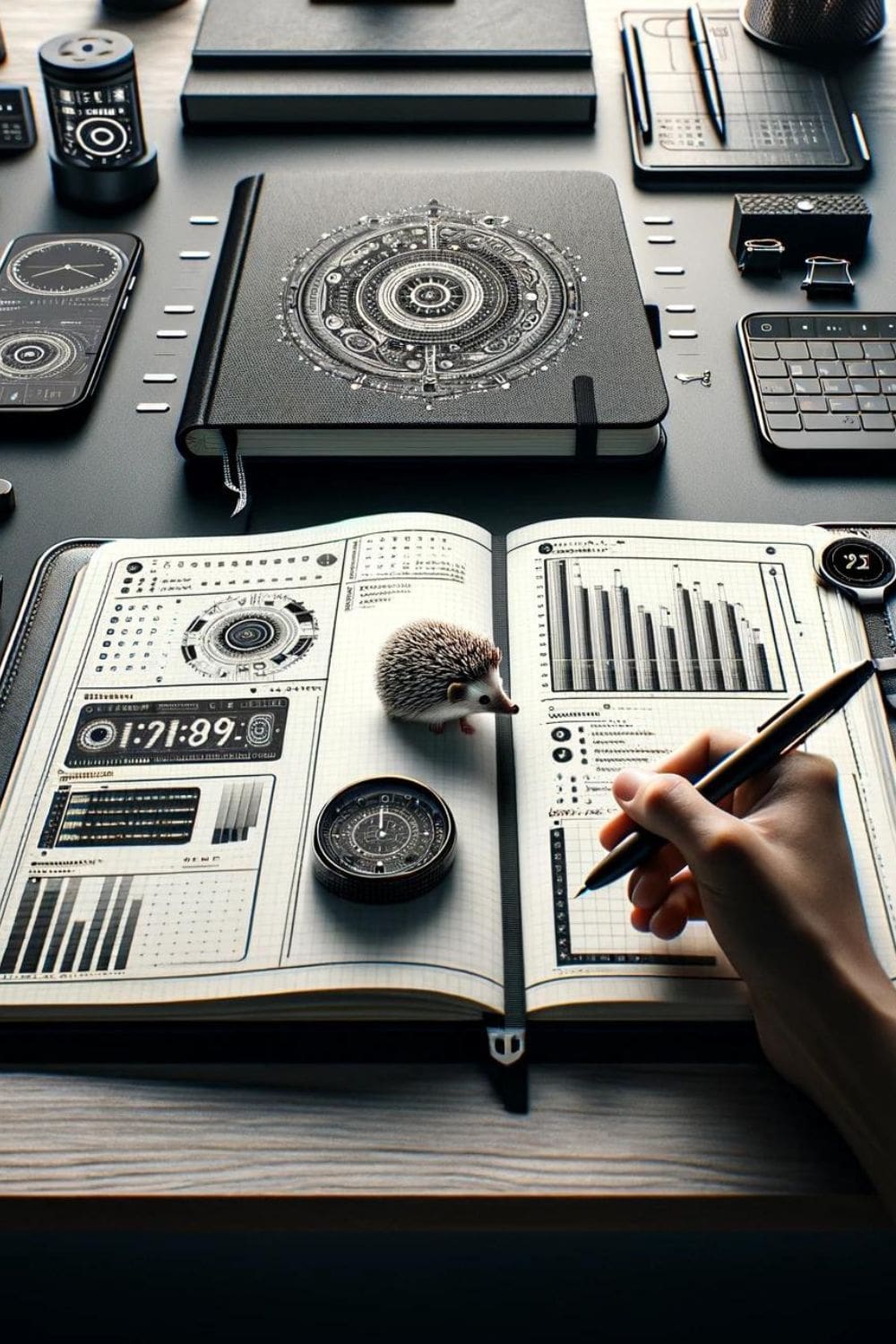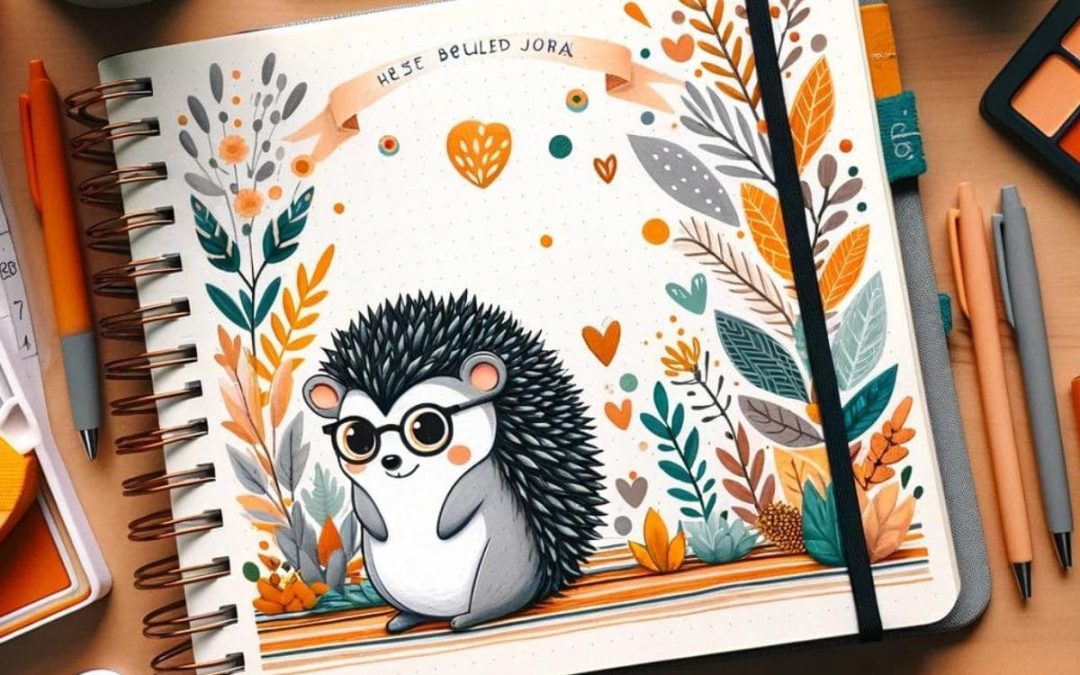So, what exactly is Bullet journaling?
- It is a flexible way to organize tasks, notes, and life.
- It starts with a blank notebook.
- It can be as straightforward or as complex as you want.
- It takes a bit of forethought to figure out what you want.
- Traditionally, it is done with paper, but digital bullet journaling is now famous.
Bullet journaling has emerged as a customizable and flexible method of organizing one’s life, tasks, thoughts, and priorities. Something to consider, though, is that flexibility can also wind up being overwhelming.
Often referred to as an analog system in a digital world, it stands out due to its adaptability to different lifestyles and needs.
The core of bullet journaling involves a notebook that allows for the following:
- A mix of scheduling
- Reminders
- to-do lists
- Brainstorming
- Notes
- Habit Trackers

Individuals turn to bullet journaling to track what they need to do and as a creative outlet to record their past experiences and plan their future goals. It offers a unique blend of productivity and mindfulness, encouraging users to live more intentional and organized lives.
I find the mix between mindfulness and organization to be quite valuable. It is easy for the day to get away from me. Documenting the day in my Bullet Journal has been eye-opening and not always in a good way.
With its simplicity and effectiveness, bullet journaling has continued to grow in popularity, attracting all types of folks looking to declutter their minds and manage their time more efficiently.
Key Takeaways
- Bullet journaling serves as a versatile tool for organization and personal reflection.
- It promotes productivity and intentionality through customized planning and tracking.
- Starting a bullet journal requires a notebook and a willingness to experiment with its system.
What Is Bullet Journaling?
Rapid logging, modules, indexing, and collections are at the core of bullet journaling. These elements allow users to jot down information quickly via symbols or bullets, organize it into distinct categories, and easily reference it later.
Bullet journaling is an inventive organizational system that combines planning, tracking, and journaling into one personalized method. It’s a unique analog system in a digital age, designed to adapt to one’s evolving needs and preferences. Individuals use bullet journals to capture everything from daily to-dos to long-term goals, all within the creative confines of a notebook.
Why Bullet Journaling
Enthusiasts of bullet journaling revel in its unique blend of productivity and mindfulness. What makes it so compelling?
- Customizable Layouts: Individuals tailor their journals with entries that fit their routines and preferences.
- Artistic Expression: Paginated canvases invite an infusion of creativity, from simple sketches to elaborate spreads.
Bullet journaling begins as a simple organizational tool but often blossoms into a multifaceted hobby that can include artistic expression. For those who love crafting lists and checking off tasks, it offers a satisfying way to track accomplishments and fine-tune goals.
Its inception, crafted by Ryder Carroll, was as a system designed to be as minimalistic or complex as the user desires. Users track their past, organize their present, and plan for the future, all while affording moments of reflection that contribute to a mindful lifestyle.
The method also emphasizes flexibility: entries can be migrated, updated, or altered to fit the changing nature of one’s schedule and goals.
Here’s a glance at its main appeals:
- Efficiency: Streamlined logging of tasks, events, and notes.
- Mindfulness: Encourages reflection to ascertain one’s priorities.
- Creativity: Offers a canvas for personal touches through doodles and design.
They find bullet journaling an easy-to-adapt system and a way of life that evolves with each page turn.

Getting Started with Bullet Journaling
Starting a bullet journal is the beginning of a journey. You are entering a new world of organization and creativity. Just remember that you are in control. One starts with selecting the right tools, understanding the basic structure, and learning the unique symbols that make bullet journaling effective.
Choosing Your Tools
Notebooks: One can choose any notebook, but many prefer one with a dot-grid format for flexibility in design and layout. The paper’s thickness and the cover’s durability are also considerations for frequent use.
I have learned how vital the thickness of paper is when bullet journaling. I will share more about this in the future, but trust me, this matters a lot.
- Pens: Look for pens with smooth writing that won’t bleed through the pages. Having a variety of colors can be helpful for color-coding entries. Color is more important than I anticipated.
- Rulers: A ruler proves handy to create clean lines, which is particularly important for layouts and calendars. I had to search high and low for a ruler.
- Additional Accessories (optional): Stickers, washi tapes, and stencils can add personality and fun to the bullet journaling experience. So far, I haven’t used this, but I can see the appeal.
Basic Bullet Journal Structure
Bullet journals generally comprise four core modules:
- Index: A table of contents that helps to find content quickly.
- Future Log: This is a space to jot down events or tasks that are due in the future beyond the current month.
- Monthly Log: It is a calendar and task list for the month, offering an overview of upcoming commitments.
- Daily Log: The heart of the bullet journal, where daily tasks, notes, and events are recorded in real time.
Key Symbols and Signifiers
The magic of bullet journaling lies in its use of symbols. Here’s a quick reference:
- Task Bullets (•): Symbolizes tasks.
- Events and Appointments (O): Circles denote events or appointments.
- Notes and Observations (-): A dash is used for notes, thoughts, and observations.
- Priority (*): Stars or asterisks mark high-priority items.
- Inspiration (!): Exclamation marks highlight great ideas or inspirations.
People may adapt the symbols to their preferences and needs, but these serve as the standard starting point. You will likely develop your symbols or keys in time. For example, this blog ReneeInspired is RI in my bullet journal.
One final important detail. Bullet Journal is a lot to say over and over or type over and over. So you will often hear it referenced as Bujo. So, know that Bujo = Bullet Journal.

